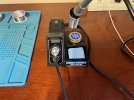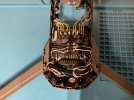You are using an out of date browser. It may not display this or other websites correctly.
You should upgrade or use an alternative browser.
You should upgrade or use an alternative browser.
Soldering skills (not mine!)
- Thread starter Starz
- Start date
Yorkshire_Pud
Well-Known Member
A 1 I think.
DIY or 'pro' ?
What might be more interesting is. ....
What is the cause of the bad soldering ? E.g. iron temp too low or not powerful enough etc. ?
I have read that the joints should be smooth and ' spherical.
Is that correct ?
DIY or 'pro' ?
What might be more interesting is. ....
What is the cause of the bad soldering ? E.g. iron temp too low or not powerful enough etc. ?
I have read that the joints should be smooth and ' spherical.
Is that correct ?
Last edited:
Cafguy
Well-Known Member
Hardware store soldering irons and solder! Noooooo....
I'll give it a 2 for effort-- I would throw it out and try again. Give your friend this video:
I'll give it a 2 for effort-- I would throw it out and try again. Give your friend this video:
YVRGUY
Well-Known Member
I’ve done two leg replacements on some crashed Mini 2’s and these tiny boards are not easy to work on. Besides the rerouting of the wiring and the re assembly of the body after, it is then you test your repair with fingers crossedOn a scale of one to ten, ten being best, this one is a two. View attachment 172818
I’d give this a solid 6 out of 10.
The iron is too hot, and the person was constantly trying to get the solder hot and the wire held in place and get the iron out of there way too fast. It’s actually not bad, considering. Almost all of the solder is smooth. There are some burn marks on the board and some melted insulation. There’s a lot of sloppy wire prep. *Maybe* there are one or two cold joints. Hopefully none of the components are burnt.
Better tools for circuit-board level work would help a lot. The right solder (low temp fine), the right fine iron or tip or setting for lower temp, and good stripping and prep work (tinning) for the wires.
The iron is too hot, and the person was constantly trying to get the solder hot and the wire held in place and get the iron out of there way too fast. It’s actually not bad, considering. Almost all of the solder is smooth. There are some burn marks on the board and some melted insulation. There’s a lot of sloppy wire prep. *Maybe* there are one or two cold joints. Hopefully none of the components are burnt.
Better tools for circuit-board level work would help a lot. The right solder (low temp fine), the right fine iron or tip or setting for lower temp, and good stripping and prep work (tinning) for the wires.
Definitely not pro. I wouldn’t even attempt a test flight with this one. Wires weren’t even placed back into their respective holders. Frayed wires hanging away from where they should be. Without knowing what tool was used, can’t answer details.A 1 I think.
DIY or 'pro' ?
What might be more interesting is. ....
What is the cause of the bad soldering ? E.g. iron temp too low or not powerful enough etc. ?
I have read that the joints should be smooth and ' spherical.
Is that correct ?
I will not own anything that says”Weller” ever again. Current tool that I use below.

Cafguy
Well-Known Member
Wellers are for plumbers! lolI will not own anything that says”Weller” ever again.
What you got yourself there is a nice setup The temp adjust is a must have for working on drones.
Yorkshire_Pud
Well-Known Member
That bench is unhealthly tidy ......... where's the clutter and unfinished jobs ???????????Current tool that I use below.
Not letting anyone see that! Clutter kept at a minimum for the benefit of doing what needs to be done and not mess up what is being worked on.where's the clutter
Last edited:
360 Guy
Well-Known Member
If that was mine (NOT) nothing would work, but seeing that, I bet everything works 100%. (for a  while)
while)
Kuiper Denizen
Well-Known Member
Yeah…!That bench is unhealthly tidy ......... where's the clutter and unfinished jobs ???????????
This looks like the work space of that guy who got straight “A”s in eighth grade! We all hated him because he made the rest of us look bad.
He probably went on to oversee programs for NASA.
Or worse, repair his drone in less than an hour with no added broken soldering, melted housing, lost screws, and third degree burns.
Oooh how we still envy him through feigned loathing.
(Will he fix my messes?)
waynorth
Well-Known Member
- Joined
- Aug 28, 2018
- Messages
- 902
- Reactions
- 991
I hope you are happy with it, because I just ordered a similar one. Surprisingly inexpensive, around £30 incl. extra tips, flux and solder.Current tool that I use below.
View attachment 172835
What I have learned is to turn it off when not needed. I think leaving the weller units on that I had was why they didn’t last. If the next soldering task is more than 1 minute away, it gets turned off. This one does have a sleep feature, but it doesn’t enter that mode for 10 minutes. The heat up cycle from off is not long at all.I hope you are happy
Ronny St.
Well-Known Member
A 1 or, at best, a 2. It is a very messy job and I wouldn't trust the connections made in this way 
ScottTX
Well-Known Member
I would give it a 1 or 2 also. I'm an electronic hardware engineer and I've soldering for 50+ years.
I've also had some decent Weller soldering stations throughout the years. But there are lots of good alternatives these days.
I've also had some decent Weller soldering stations throughout the years. But there are lots of good alternatives these days.
Ronny St.
Well-Known Member
My score was given based upon personal experience too. I am a ham operator and home-builded numerous electronic projects myself. As a matter of fact, this week I soldered a microprocessor-based system for training my CW (morse) and it works like a charm 
ScottTX
Well-Known Member
"a microprocessor-based system for training my CW" Do tell. I learned CW enough to pass my HAM tests, but now I am considering revisiting CW.My score was given based upon personal experience too. I am a ham operator and home-builded numerous electronic projects myself. As a matter of fact, this week I soldered a microprocessor-based system for training my CW (morse) and it works like a charm
WaltBen
Member
Absolutely right about the iron being too hot - that's why so much of the wires are bare. I'd hate to see what the underside of the board looks like and I really think you're being too charitable at a 6 - this is more like a 4.I’d give this a solid 6 out of 10.
The iron is too hot, and the person was constantly trying to get the solder hot and the wire held in place and get the iron out of there way too fast. It’s actually not bad, considering. Almost all of the solder is smooth. There are some burn marks on the board and some melted insulation. There’s a lot of sloppy wire prep. *Maybe* there are one or two cold joints. Hopefully none of the components are burnt.
Better tools for circuit-board level work would help a lot. The right solder (low temp fine), the right fine iron or tip or setting for lower temp, and good stripping and prep work (tinning) for the wires.
Similar threads
- Replies
- 2
- Views
- 668
- Replies
- 37
- Views
- 2K
- Replies
- 19
- Views
- 1K
- Replies
- 2
- Views
- 709
DJI Drone Deals
New Threads
-
-
US exempts some foreign-made drones from FCC import ban on new models
- Started by Occams Razor
- Replies: 2
-
-
5P has that crazy Air 3S RTH under trees, through buildings
- Started by Droning on and on...
- Replies: 1
-
Members online
Total: 2,157 (members: 12, guests: 2,145)










